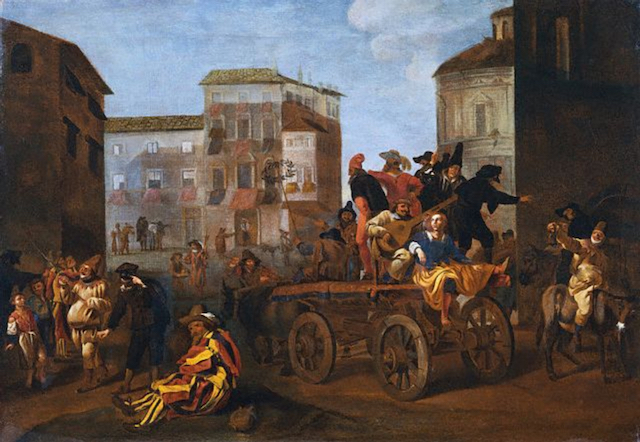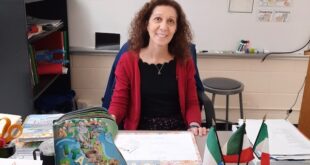
Agostino Dessi is one of the premier mask makers in Italy. For more than 50 years, he has fashioned magnificent facial adornments in celebration of Carnevale in Venice as well as Commedia dell’Arte, a 500-year-old tradition of improvised theater in Italy.
I recently had the opportunity to meet Agostino in the mask workshop of his daughter, Alice. Dubbed Alice’s Masks, it is located at Via Faenza 72R in central Florence, not far from the Central Market and San Lorenzo Church.
 A visit to the shop offers a wonderful perspective on the street theater of Italy. Perhaps a raucous Commedia company in the Piazza Santa Croce once gave Leonardo or Michelangelo a chuckle in the streets right outside of where their studios now sit.
A visit to the shop offers a wonderful perspective on the street theater of Italy. Perhaps a raucous Commedia company in the Piazza Santa Croce once gave Leonardo or Michelangelo a chuckle in the streets right outside of where their studios now sit.
As a professor at Northwestern University and the University of Detroit, I taught theater students the glories of this tradition for 40 years.
From the start, Commedia has had no scripts, only scenarios posted backstage. Actors would check the plot outline before making their entrance onto a primitive wagon to improvise their story while an enthusiastic audience hooted and hollered its enjoyment.
It was a Golden Age for actors, who were also virtuosic singers, musicians, acrobats, dancers, magicians and, of course, improvisers. A sort of Second City on steroids, Commedia spawned performers who took their talents on the road to theaters and opera houses across Western and Eastern Europe.
Commedia embraces a cast of stock characters, including a host of wily servants with distinct personalities, all of whom are anxious to visit mischief upon their masters. Among them are Arlecchino (Harlequin), Pulcinella, Brighella and Columbine. Then there are the “professional” characters, like the miserly father, Pantalone; the foolish, Latin-spouting scholar, Il Dottore; and the braggart soldier, Il Capitano.
Characters all wear distinctive costumes that immediately identify them: Antic Arlecchino with his colorful, form-fitting attire; sad-sack Pulcinella with his billowy, white pajamas; and blustery Il Capitano with his military finery, the more plumes the better. All wear distinctive masks, except for the young lovers, whose faces are there for all to see.
 Throughout the centuries, painters like Watteau and Picasso, composers like Pergolisi and Stravinsky, and choreographers like Michael Fokine and George Balanchine have created hundreds of works of art that celebrate the world of Commedia. And this brilliant period of theater had an enormous influence on the colorful pre-Lenten Carnevale celebration in Venice and other Italian cities.
Throughout the centuries, painters like Watteau and Picasso, composers like Pergolisi and Stravinsky, and choreographers like Michael Fokine and George Balanchine have created hundreds of works of art that celebrate the world of Commedia. And this brilliant period of theater had an enormous influence on the colorful pre-Lenten Carnevale celebration in Venice and other Italian cities.
Agostino Dessi was born in 1952 in a small town on the island of Sardinia. He hoped to study art and sculpture in the great cities of Italy, but once he arrived in Florence in 1973, he decided he had found his artistic home. Soon he was applying his talent as a sculptor to his love of “il maschera,” and his work was being shown regularly. Commissions followed from theater and opera companies that coveted his masks for their productions.
Commedia masks are traditionally made of leather, but Agostino prefers to work in papier mâché and more recently in latex. He and AIice offer workshops in mask making during the last week of every month, and to preserve the art form for future generations, he trains budding artisans through a two-year apprenticeship.
When I entered the shop in Florence, I felt I had arrived in Commedia heaven! In addition to the thousands of masks hanging from the ceiling and walls, the space is filled with statues, puppets, miniature theaters and all other manner of objects related to the characters of Commedia.
My greatest pleasure in visiting Alice’s Masks was the opportunity to meet the brilliant Agostino Dessi and watch him at work in the studio. It was an even greater pleasure to have the maestro inscribe his book, “The Masks of Agostino Dessi,” for me. It was a very special souvenir of my visit to Firenze.
For details, click here.
 Fra Noi Embrace Your Inner Italian
Fra Noi Embrace Your Inner Italian








I am so impressed with Professor Dessì’s incredible masks. My wife and I have visited his shop many times since 2005 and have purchased 40+ masks and sculptures. He is a very nice man and a master at his craft.
I am privileged to own the very large mask of Michelangelo’s ‘David’, truly rare and beautiful. I contacted Alice years ago regarding this mask and she was lovely to communicate with. I would love to acquire his book but it is scarce. Thank you for your artistry and generosity. Agostino and Alice. The world is better and more beautiful for it.